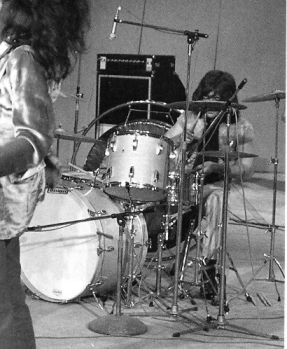

Like many Rock musicians, Bonham received some basic skills training but mainly learnt from listening. Among those he listened to were the leading drummers in England at the time – Baker and Moon. He also listened to the soul/funk drummers such as Zigadoo Modeliste, Benny Benjamin and Clyde Stubblefield. These drummers were pared down groove players. They provided the basic style but Bonham added the power bass drum approach of Moon and Baker’s strong clean chops. The result was an aggressive power groove style that was able to fit into a variety of contexts including Blues and R&B.
His early bands in the Midlands were Crawling King Snakes (Blues) and Band Of Joy (R&B/Blues/Pop). He built a reputation and moved into session work. In July 1968 he got a call from his old band mate, Robert Plant. It took some talking from Plant and Page but in August he came on board to join the New Yardbirds. In October they changed their name to Led Zepplin but found it hard to get gigs in England, mainly because of the performance fees they demanded.
In December they started a short US tour as support to such bands as Vanilla Fudge and Iron Butterfly, which they reputably "blew them off the stage". Interestingly they couldn’t do it against The Who in May. In February ’69 their, quickly recorded, eponymous 1st album was released. The influence of the Rock Blues of Cream and Jeff Beck permeates this album. The really original component was Bonham’s drumming coupled with John Paul Jone’s heavy bass line. The drumming is loud, powerful groove playing heavily emphasising the beat but still with quite a variety of neat embellishments.
The flair on the first album was gradually eliminated as the solid groove beat was emphasised. Bass drum triplet patterns or back beat, strong crash/riding of cymbals, single snare strokes with little riding, very loud on the beat pedal playing and pounding of the hi-hat, simple power excursions onto the toms. It was extraordinarily effective on most songs but at times I would like to hear more subtlety e.g. "Stairway to Heaven". He had an unerring sense of time even with Led Zepplin's occasional more complex time signatures. Compared to what was going to come from his acolytes, he was relatively inventive and interesting.
Bonham’s approach was a major contributor to the popular success of Led Zepplin’s heavy rock: solid heavy rhythm section with soaring blues based guitar and vocals over the top. The complex rhythmic patterns of a Baker or flying fills of a Mitchell had no place in this distillation. Led Zepplin’s "BBC Sessions" showcases the devolution. Just as Baker and Mitchell had simplified Jazz drumming to fit into Rock, Bonham had simplified again to produce Heavy Rock drumming.
John’s approach is reflected in his Ludwig kit: 26" bass, 13x13" top, 16x16" & 18x18" floor, Ludwig 6.5" Supra-phonic snare, 15" hi-hat, 20" & 24" rides, 20" & 24" crashes augmented by tympani and gongs. He later adopted Ludwig’s clear Vista Lites with 15x15" top tom and 18"x 18" & 20"x20" floor. The kits were played with all heads on – even when miked and in the studio. Matched grip using heavy sticks and often the mallet end. He sat low and used high power strokes much like Baker but miking allowed him to economise. His sound was thunderous, especially as he was miked for most of his career – I heard him outdoors in 1972 and it was a battering experience.
Bonham’s "Toad" was entitled "Moby Dick". Baker’s solos are long and for many dull, but Bonham’s were excruciatingly long, loud and boring. He simply did not have the technique to carry through a long solo. His groove turned into a very deep furrow, though for many that was quite acceptable listening. His approach is more reasonably compared to his contemporary Ian Paice of Deep Purple who also emphasised the Rock groove but showed much greater flair and variety in his more concise solo piece "The Mule".
Bonham does not have the technical skills of Baker or Hiseman, the flair of Mitchell or the spontaneity of Moon. He developed an approach that reflected his great physical strength – "I’m a simple, straight ahead drummer and I don’t try to be anything better than I am." It also meant that he remained extremely effective as he physically declined, unlike Moon.

John Bonham was the major contributor to the development of the drum sound of Heavy Rock and is the most influential drummer in Rock Music, at least in the ‘70’s and into the ‘80’s.
Finest Moments: "Good Times Bad Times" (damn brilliant piece of drumming with shades of Baker & Moon), "Dazed and Confused", "Black Dog/Rock and Roll", "The BBC Sessions".
© Graeme Pattingale 1999